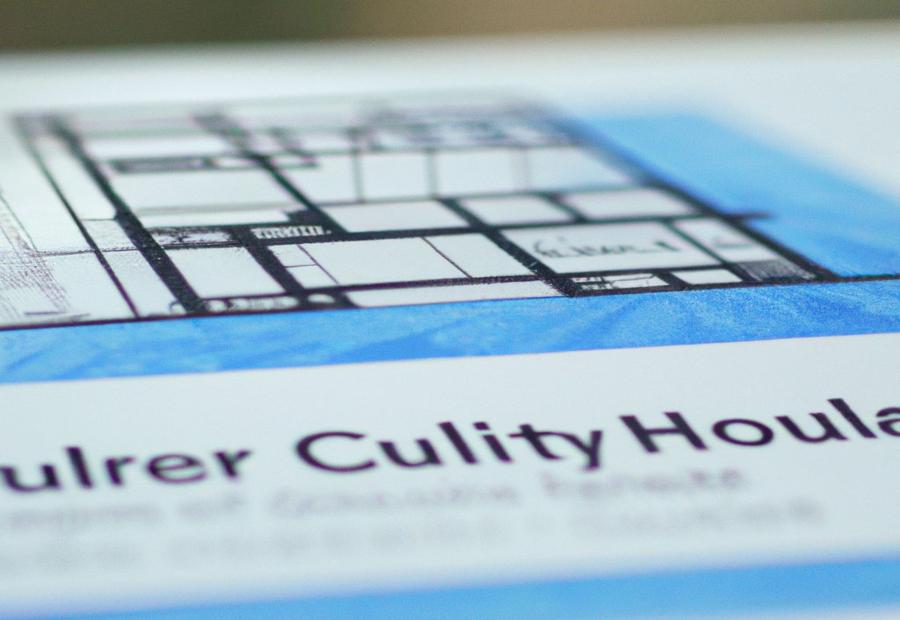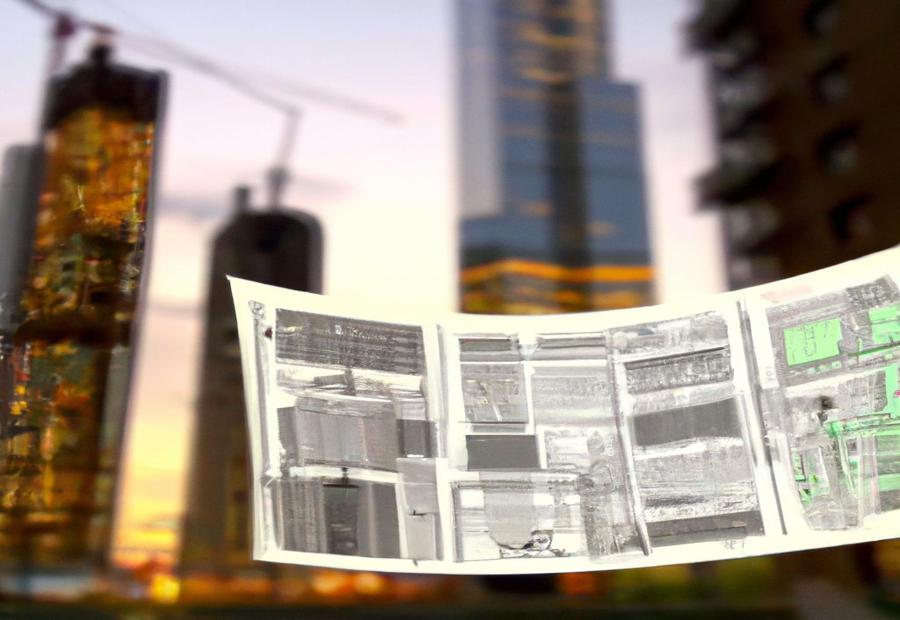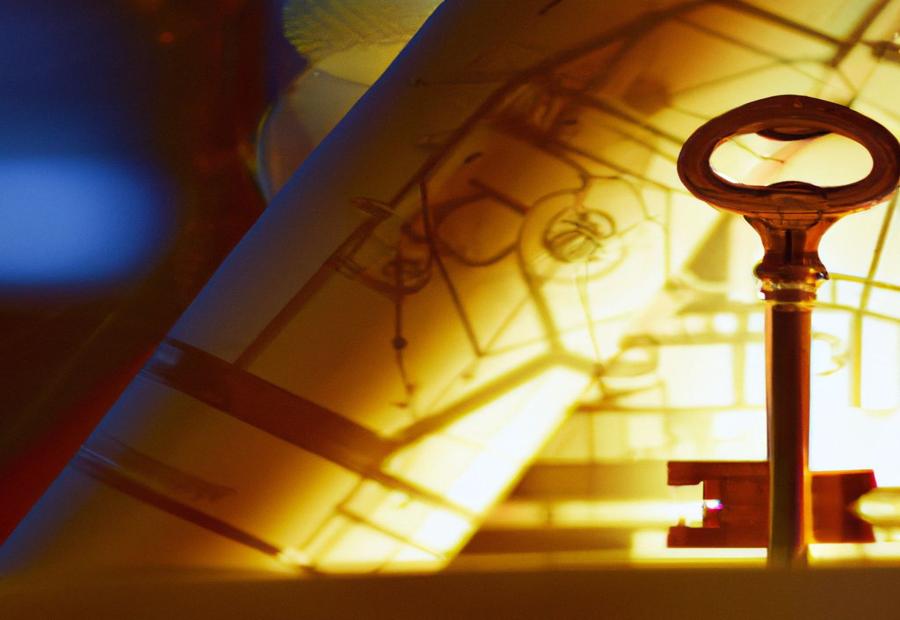Key takeaway:
- Permanent construction loans provide financing for building projects that will become a permanent structure, offering a long-term financing solution.
- Understanding the basics of permanent construction loans, including the types, benefits, and drawbacks, is essential for borrowers considering this financing option.
- To qualify for a permanent construction loan, borrowers need to consider their credit and financial situation, make a down payment or provide upfront cash, and have experience in construction.
- The application process for a permanent construction loan involves drafting detailed construction plans, finding a lending bank or private lender, and going through application and approval processes.
- Managing the loan and construction process requires careful consideration of the construction timeline and costs, setting aside contingency and interest reserves, and working with architectural plans to build the desired house.



Photo Credits: Build-Wire.Com by Austin White
Permanent construction loans play a crucial role in securing your financing for construction projects. In this section, we’ll explore what permanent construction loans are and how they actually work. Get ready to dive into the ins and outs of this essential financing option that can make all the difference in bringing your construction dreams to reality.
What are Permanent Construction Loans?
Permanent construction loans are an attractive financial product for those looking to build a house or commercial building. They provide funding throughout the entire construction process and convert to a long-term mortgage once the building is finished.
Advantages of this kind of loan include being able to finance both the purchase of land and the cost of construction. Plus, borrowers have access to funds for materials, labor, and other construction-related costs.
Interest rates on these loans are competitive, and they usually have more flexible repayment terms and lower down payment requirements than regular mortgages. But, the application process is more complex and time-consuming, and lenders may ask for detailed documentation and stricter credit and financial requirements.
Having a good credit score is important, and lenders may also need a significant down payment. Experience in construction and hiring professionals like builders or contractors can also help when applying.
Architectural plans, a detailed budget, and timeline management are also essential. You should also research different lenders, compare interest rates, terms, and fees. Setting aside contingency reserves and interest reserves is also recommended.
How Permanent Construction Loans Work
A permanent construction loan is a type of loan for financing the building of a new home or structure. When the building is finished, the loan changes to a permanent mortgage. This helps people obtain money for their construction project and then smoothly transition into their permanent funding without going through the approval process again.
This is an overview of how permanent construction loans work:
- Create plans: Make plans and write out a detailed construction plan that lists all the steps and costs required in the project.
- Find a lender: Look for a bank or private lender that gives out permanent construction loans. Do your research and choose a reliable institution with experience in this kind of financing.
- Submit an application: After you pick a lender, apply for the loan. This includes giving financial documents, credit history, and evidence of income.
- Approval process: The lender will assess your application and decide if you meet their requirements. They will look at factors such as credit score, financial security, and experience with construction.
- Construction timeline and costs: When approved, start the construction following your timeline and costs from your plan.
- Conversion to permanent mortgage: When the construction is done, the loan changes to a permanent mortgage according to the terms such as interest rate, repayment period, and month-to-month payments.
Apart from these steps, it’s important to keep in mind that managing the loan and construction process needs careful planning and monitoring of costs. Contingency reserves could be needed for unforeseen expenses during construction, while interest reserves may be mandatory to pay interest payments during the construction stage.
All in all, having financing through a permanent construction loan gives borrowers a smooth transition from the construction to being a homeowner or owning a commercial property. By understanding these loans and making sure you meet the standards, you can start your construction project with confidence.
Understanding the Basics of Permanent Construction Loans



Photo Credits: Build-Wire.Com by Lawrence Thomas
Understanding the basics of permanent construction loans is essential for securing your financing. In this section, we will explore the various types of construction loans available, the benefits they offer, and the potential drawbacks you should be aware of. By gaining insights into these key aspects, you’ll be equipped with the knowledge to make informed decisions and ensure a smooth financial journey throughout your construction project.
Types of Construction Loans
Build your dream home with the help of construction loans! They come in three types:
- Construction-to-Permanent: A single package for both construction and mortgage. Short-term loan during the build, then converts to traditional mortgage.
- Stand-Alone Construction: Funds for just the construction. Need separate mortgage when complete.
- Owner-Builder: For those who want to be their own contractor. Funds for materials and subcontractors.
Before deciding, think which one best suits your needs. Permanent construction loans are the best way to turn your dream into reality!
Benefits of Permanent Construction Loans
Permanent Construction Loans offer many perks to those seeking to finance construction projects. These loans provide financial flexibility to cover both building costs and long-term financing, making borrowing simpler. Interest rates are often competitive compared to other loan types, resulting in savings over the life of the loan. Repayment terms are flexible, allowing borrowers to customize their schedule to fit their needs.
Funds are easily accessible during the construction process, helping make timely payments to contractors and suppliers. This ensures projects stay on schedule and avoids delays due to a lack of finances. For those with limited resources or credit history, these loans can be a valuable tool.
Overall, Permanent Construction Loans are an attractive option for construction projects. Financial flexibility, competitive interest rates, and flexible repayment terms can help borrowers complete projects while managing finances.
Drawbacks of Permanent Construction Loans
Permanent construction loans have a few downsides. Interest rates are higher than the ones attached to traditional mortgages, and repayment terms are shorter. This can make monthly payments more expensive. Additionally, construction projects can involve extra costs and delays, potentially resulting in budget overruns. Not all lenders offer permanent construction loans, so borrowers may have fewer options.
It is essential to consider all the potential drawbacks before signing up for a permanent construction loan. Every borrower is different, so careful thought is required. Even though there are downsides, these loans can still be a great way to finance a property build or renovation.
Borrowers should be aware that they have to meet strict criteria to be eligible for a permanent construction loan. This includes having a good credit history, as well as sufficient income and assets.
Qualifying for a Permanent Construction Loan



Photo Credits: Build-Wire.Com by Tyler Ramirez
Qualifying for a permanent construction loan is a crucial step in securing your financing. In this section, we’ll discuss the key factors that lenders consider for approval. From examining credit and financial considerations to evaluating down payment requirements and upfront cash, as well as assessing previous experience in construction, we’ll provide you with valuable insights to help you navigate the qualification process successfully.
Credit and Financial Considerations
When applying for a construction loan, credit and financial factors are important. Lenders examine credit history, including credit score, payment history, and debts. A great credit history is necessary.
Income level and debt-to-income ratio matter too. Lenders consider current income and debt-to-income ratio to decide if the loan can be handled. Manage debt and keep a good income level.
Financial stability is key. Lenders check employment and income streams to confirm that the construction project can be finished. Stable finances are vital.
Project feasibility is also looked at. Lenders evaluate projected costs, potential returns, and market conditions to make sure the loan can be repaid. Borrowers should do research for assurance.
Insurance is essential. Borrowers must provide proof of insurance coverage for existing property (if applicable) and during construction. This safeguards against risks or damages.
Unique requirements may be needed for the lender or loan program. This could include documentation or extra financial disclosures.
These credit and financial considerations should be prioritized. This will increase the chances of getting a loan and gaining lenders’ confidence. Credit standing, debt-to-income ratio, income sources, and insurance coverage are important steps in getting a loan and financing construction projects.
Down Payment and Upfront Cash
This table offers an overview of Down Payment and Upfront Cash:
| Aspect | Description |
|---|---|
| Down Payment | Borrowers usually have to give a down payment, which is a % of the total loan amount. This proves the borrower’s commitment and minimizes the lender’s risk. |
| Upfront Cash | In addition to the down payment, borrowers should have cash upfront to pay for various costs like architectural plans, permits, engineering reports, and other pre-construction costs. |
It’s noteworthy that the exact requirements for Down Payment and Upfront Cash may vary based on factors like the borrower’s creditworthiness, the loan size, and the lender’s policies.
In some cases, lenders might let borrowers finance a part of the upfront costs into the loan amount. But this increases the total loan amount and monthly payments.
Knowing these financial details is key when applying for a Permanent Construction Loan. By having enough funds for both down payment and upfront cash needs, borrowers can improve their chances of getting a loan.
Take John and Sarah, for example. They wanted to build their dream house but had limited savings. They saved money for years for their down payment and also put away extra funds for upfront cash expenses. Their commitment paid off when they were accepted for a Permanent Construction Loan since they revealed financial responsibility and were ready for the project’s costs.
Experience in Construction
Experience in construction is key when applying for a permanent loan. Lenders check a borrower’s level of experience to assess their capability of completing the project well and mitigating risks.
Having construction experience boosts the chances of loan approval and makes lenders trust that the borrower can handle the job, avoiding possible problems due to cost overruns or delays.
Besides assessing experience in construction, lenders may also look at things like formal education or training in fields like engineering or architecture. These qualifications strengthen a borrower’s reputation and prove their commitment to quality.
A case in point is a borrower with no prior experience taking on a big residential development project. Even though they had enough money, they faced difficulties due to a lack of knowledge about complex building processes. This caused significant cost overruns and delays, causing problems for both the borrower and lender.
The Application Process for a Permanent Construction Loan



Photo Credits: Build-Wire.Com by Ethan Johnson
The application process for a permanent construction loan is a crucial step in securing your financing. In this section, we will explore the key elements involved in this process. From drafting detailed construction plans to finding a suitable lending bank or private lender, we’ll guide you through the various stages of the application and approval processes. By understanding the essential steps, you’ll be better equipped to navigate the loan application journey and increase your chances of success.
Drafting Plans and Detailed Construction Plan
Drafting plans involve creating architectural drawings that show the design, size, and layout of the building. These are essential for permits and meeting building codes and regulations.
A detailed construction plan with info on materials, labor, and timeline helps estimate costs and keep the project on track. It also impresses lenders, showing your ability to manage the project and increasing chances of getting a loan.
Moreover, contractors use these plans for understanding the project and ensuring everything is done as per plan. Creating accurate plans requires expertise in architecture or engineering, so having an experienced professional or team is highly recommended.
Finding a lender is like searching for a needle in a haystack – the needle being money and the haystack being banks that don’t want to give it!
Finding a Lending Bank or Private Lender
Finding the right lending bank or private lender is important for your construction project’s success. Here’s a 6-step guide to assist you:
- Research potential lenders offering permanent construction loans. Look for reputable banks, credit unions, and private lenders with experience.
- Evaluate lender requirements. Think about credit score, debt-to-income ratio, and construction experience.
- Gather necessary docs, like financial statements, tax returns, and building plans.
- Compare loan terms. Get quotes from multiple lenders and look at down payment requirements, repayment terms, and extra fees.
- Seek recommendations from industry professionals or friends who have obtained construction loans.
- Consult a mortgage broker who specializes in construction loans.
Tip: Build relationships with local banks or credit unions to increase chances of getting favorable loan terms in the future.
Application and Approval Processes
To secure funding for your construction project, it’s important to follow the steps of the application and approval process for a permanent construction loan.
- Fill out an application with details about your project, finances, and experience. Include all necessary supporting documents.
- The lender will review and assess your project’s viability. They’ll consider creditworthiness, income, and the value of the finished project.
- The lender will evaluate the collateral that secures the loan, such as the property or other assets. This helps decide the loan amount.
- The lender will analyze your financials. This includes credit history, income verification, and debt-to-income ratio. This process determines if you meet their lending criteria.
- If approved, you’ll get an offer letter with terms and conditions. Carefully review these before accepting the loan.
Accuracy and timely submission of documents will help get the loan process moving. Construction is a tricky game, so be prepared!
Managing the Loan and Construction Process



Photo Credits: Build-Wire.Com by Ronald Jones
Managing the loan and construction process is crucial when securing your financing with a permanent construction loan. In this section, we’ll explore key aspects such as the construction timeline and costs, contingency reserves and interest reserves, as well as the importance of architectural plans when building a house. By understanding these elements, you can effectively navigate the loan process and ensure a smooth construction journey.
Construction Timeline and Costs
Permanent Construction Loans provide money for the building of a house or building, and the long-term financing needed when construction is complete. This includes the timeline and costs related to building.
For understanding the timeline and costs, it is helpful to see them in a table format. For instance:
| Construction Phase | Estimated Timeframe |
|---|---|
| Planning and Preparations | 1-3 months |
| Foundation and Framing | 2-6 months |
| Interior Work | 2-4 months |
| Exterior Finishing | 1-3 months |
| Final Inspections and Occupancy | 1 month |
The timeframe and costs depend on various factors. These include materials used, location, labor expenses, and any surprises that may arise during construction.
Apart from these details, it’s important to remember that managing the loan and construction process needs careful planning. This includes setting aside money for unexpected costs and interest payments during the building phase.
In conclusion, it is essential to know the construction timeline and costs for securing a permanent construction loan. Estimating them accurately can help to stop delays and financial problems during the building.
Moreover, ‘Securing Your Financing with a Permanent Construction Loan: An Essential Guide’ states that precise cost estimation is necessary to prevent budget overruns in construction projects. Without contingency reserves and interest reserves, a construction project is like a tightrope walk without a safety net.
Contingency Reserves and Interest Reserves
Contingency reserves and interest reserves are vital for managing permanent construction loans. They act as financial cushions to cover unforeseen costs and interest payments during the construction process.
Let’s explore their functions:
| Contingency Reserves | Interest Reserves |
| – Unforeseen expenses during construction. | – Funds for interest payments. |
| – Risks from changes in project scope. | – Cash flow for the borrower. |
Contingency reserves protect from extra costs that may arise due to factors like material prices or design changes. Interest reserves guarantee that the borrower has enough money for monthly interest payments during construction.
The amount of these reserves depends on things like loan amount, project complexity, and lender requirements. By having the right contingency and interest reserves, borrowers can manage their construction projects without major financial strain.
Understand and allocate contingency and interest reserves correctly for your construction project’s success. Ignoring these important parts of a permanent construction loan may lead to financial issues.
Architectural Plans and Building a House
Architectural plans are essential for building a house. They act as a guide, so the design is correctly implemented. Detailed plans help builders understand how to construct each stage and make sure the final product meets the right specs.
- Architectural plans show the layout, measurements, and structural elements of the proposed house.
- They let you know where every room should go, to make the most of the space.
- The plans also include window and door placements, electrical systems, plumbing fixtures, and other important features.
- By following the plans, builders can make sure all regulations and permits are met.
- The plans are also a communication tool between architects, builders, and other professionals.
- Overall, architectural plans are key to constructing a good, safe house.
Homeowners should also factor in personal preferences. Architectural plans provide a framework for custom features to fit into the design.
It’s important to remember that without plans, there is a risk of unexpected problems and costly changes during construction. To ensure success, get a permanent construction loan to finance your project.
Conclusion: Securing Your Financing with a Permanent Construction Loan



Photo Credits: Build-Wire.Com by Philip Harris
A permanent construction loan is a great way to finance your project. It converts to a mortgage once construction is finished and provides a long-term solution. This brings stability and flexibility, and eliminates the need for multiple loans.
Plus, the loan offers repayment options. You can choose between a fixed-rate or adjustable-rate mortgage, depending on your goals. This allows you to tailor the loan to suit your needs.
Moreover, you have the chance to lock in competitive interest rates. You can benefit from current low rates, and avoid potential hikes in the future. This could save money over the duration of the loan.
To make the most of the loan, you should work with a reliable lender. They will help you meet all requirements and get the best terms. Before deciding, compare the terms and rates offered by different financial institutions.
Additional Resources and References



Photo Credits: Build-Wire.Com by Samuel Flores
Navigating the complex process of securing permanent construction loan financing can be made simpler with the right resources and references. These can help you understand what’s required, the available options, and the strategies that can help you secure the financing you need.
- Lender Research: Look into construction loan specialists and compare their terms, rates, and options. This will help you find the best fit for your needs.
- Loan Requirement Knowledge: Uncover specifics on what is needed for a permanent construction loan, such as credit scores, income verification, down payment rules, and other factors lenders consider.
- Financial Expert Consultation: Reach out to mortgage brokers or financial advisors for personalized advice tailored to your financial situation.
- Government Program Exploration: Check out government programs that support construction projects and provide financing options, often with better terms and rates.
- Case Study Learning: Read case studies of successful construction projects to get ideas on strategies, challenges, and solutions.
In addition, you must understand the particular requirements for a permanent construction loan. This includes a detailed construction plan, appraisals, and financial statements.
It’s recommended to thoroughly research lenders and loan requirements, as stated in an article titled “Securing Your Financing with a Permanent Construction Loan: An Essential Guide,” for greater success with securing financing.
Some Facts About Securing Your Financing with a Permanent Construction Loan: An Essential Guide:
- ✅ Construction loans are short-term loans designed to fund the construction of a new building or home. (Source: Team Research)
- ✅ Borrowers make interest-only payments during construction, with the principal due at the end of the loan. (Source: Team Research)
- ✅ Construction loans can be obtained from a lending bank or a private lender. (Source: Team Research)
- ✅ There are different types of construction loans available, including single-close construction loans, two-time close construction loans, and construction-to-permanent loans. (Source: Team Research)
- ✅ Requirements for getting a construction loan typically include a good credit score, solid financial history, a detailed construction plan, and construction experience. (Source: Team Research)
FAQs about Securing Your Financing With A Permanent Construction Loan: An Essential Guide
What is a construction loan and how does it work?
A construction loan is a short-term financing option that provides the upfront cash needed to pay for the land, materials, and labor to build a new house or building. During construction, borrowers make interest-only payments, and the principal is due at the end of the loan term. The loan can be obtained from a lending bank or a private lender.
What are the requirements for obtaining a construction loan?
The requirements for obtaining a construction loan may vary, but lenders generally look for a good credit score, solid financial history, a detailed construction plan, and construction experience. It is also important to choose a lender with a good reputation.
What are the different types of construction loans available?
There are several types of construction loans available, including single-close construction loans, two-time close construction loans, and construction-to-permanent loans. Single-close construction loans combine the construction loan and long-term mortgage into one, while two-time close construction loans involve two separate loans for construction costs and paying off the first loan. Construction-to-permanent loans are for individuals building a new home to live in once it’s complete.
What are the advantages and disadvantages of construction loans?
The advantages of construction loans include the loan amount based on the project and future value of the property, short repayment terms, and financing options for homeowners without enough equity. However, disadvantages include a set loan amount with little flexibility, the entire balance due at the end of construction, and higher interest rates compared to other loan options.
What are the repayment terms and interest rates for construction loans?
Repayment terms for construction loans are typically short-term, ranging from 12 to 18 months. The interest rates for construction loans are generally higher than for other loan options, and they are usually variable. Interest is typically only paid on the drawn funds.
What should I consider when choosing a construction loan lender?
When choosing a construction loan lender, it is important to consider the types of loans offered, interest rates, closing costs, payment schedules, and what happens in case of delays or cost increases. It is also crucial to ensure the lender has a good reputation and can meet your specific financing needs.
